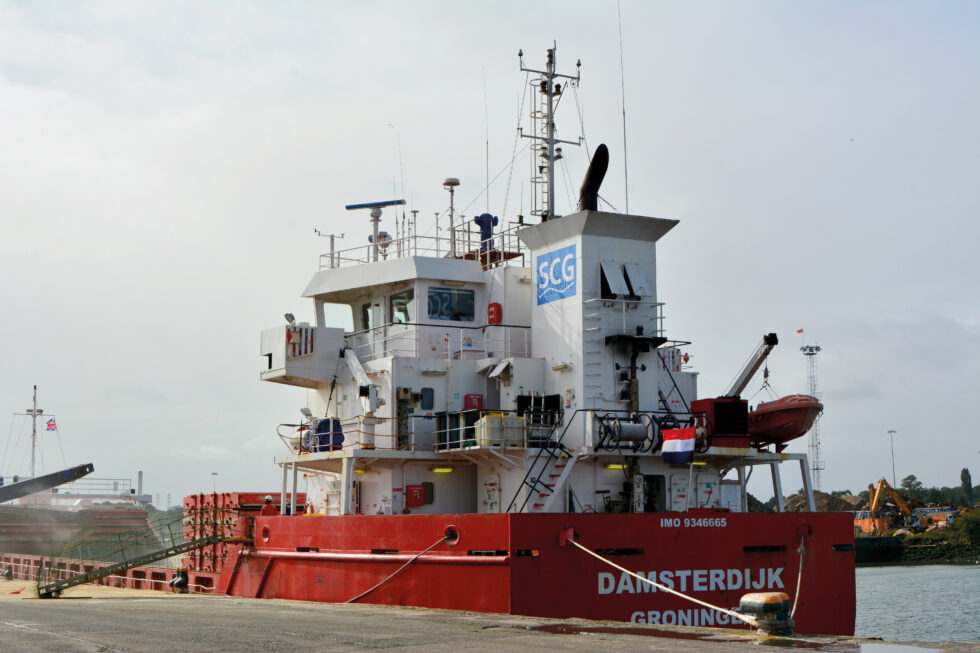
Fatal accident due to breaking of stern line - Lessons to be learned about safe working and supervision
On 2 October 2019 at around 09.45 hours local time, in the port of Ipswich (United Kingdom) a fatal accident took place on the Dutch cargo vessel Damsterdijk. While in port, the vessel had to be moved backwards over a distance of approximately 100 metres, in order to make space for another vessel. While the ship was being moved, the stern line ended up in the propeller. As a result, the line came under tension and broke. Part of the line snapped back, hitting the AB at high speed. The AB was seriously injured and later that day died as a result of those injuries.
Danger of working inside and outside the 'snapback zones'
During the manouvre in which the ship was moved backwards, the AB came into the so-called snapback zone. It is important for crew members to know in which zones they can and cannot stand during high-risk operations, and where extra caution is needed. The snapback zones on the Damsterdijk were not marked as such, or clearly indicated with signals. When the stern line came under tension and broke, a part of the line snapped back and hit the AB at high speed.
Working from a safe location
The danger of working in and around snapback zones was also described in a report published by the Board in november 2020, where a crew member was fatally injured when a mooring line parted on board the RN Privodino. Shortly after the port forward spring had been paid out, it unexpectedly came under severe tension. There was no more time to react and the mooring line broke. Part of the mooring line snapped back, killing a crew member. During the investigation into this accident, the danger of working inside and outside the snapback zones came to light. The Board made several recommendations, one of which was aimed at drastically reducing the number of broken mooring lines. A turnaround in thinking is also needed. Whereas at present the intention is to ensure that measures for working safely in unsafe areas are carried out as well as possible, working with mooring lines and ropes must be organized in such a way that at high risk moments, it is possible to work from a safe location and unsafe areas no longer need to be entered. The Board made a recommendation to the Netherlands Maritime Technology (NMT) and the Royal Association of Netherlands Ship Owners (KVNR) to, among other things, investigate how the maritime sector can contribute to achieving the objective of only working from safe workstations while handling mooring lines.
Recommendations
To Shipping Company Groningen:
1. Ensure that the ship is manned and equipped in such a way that all work on board can be carried out safely. This incident shows that the following conditions must be taken into account:
a. Bring the crew into line with the strength described in ship-specific procedures.
b. Ensuring that the regulative rest hours for the crew members are guaranteed.
c. Ensuring clear communication on board by requiring a walkie-talkie for all crew members.
d. Ensure a clear warning method for working in and near a snap-back zone.
2. Promote that crew members are sufficiently safety-aware and safety-competent to prevent accidents on board and to act appropriately in the event of imminent danger. This incident shows that several methodologies are desirable to achieve effective behavioural change, such as:
a. Regular discussion of procedures with the crew so that they understand them and see them as necessary. Review of procedures where they are no longer appropriate.
b. Talk through potential incidents (based on experience, earlier or elsewhere) which may occur on board and have the crew explore how to respond to them. This should include exercises and simulations.
c. Use the risky situations identified on board and discuss them during safety meetings. The premise is to call each other to account for actions that do not comply with the safety agreements, regardless of rank or seniority.
d. Organising specific training and exercises to further develop skills that appear to be underdeveloped.
e. Devote specific attention to training and supervision of trainees.
To the Minister of Infrastructure and Water Management:
3. Ensure that the manning proposed in a submitted manning plan is always checked for feasibility with regard to the work to be carried out, type of ship, safety procedures and emergency procedures. A safe manning certificate should only be issued if all conditions are met.
To the Royal Association of Netherlands Shipowners and to the Minister of Infrastructure and Water Management:
4. Investigate together whether the basic principle can be maintained that a crew member charged with the physical supervision of safety can also perform other duties. Apply the results when drawing up manning plans and issuing safe manning certificates.
To the Royal Association of Netherlands Shipowners:
5. Bring the lessons learned from this accident to the attention of the sector and specifically focus attention on the safe deployment of trainees and the problems mentioned in the investigation regarding manning plans and safe manning certificates.
Documents
Recommendations
Reactions
Recommendations
Reactions
- Response Dutch Safety Board to follow up to recommendations ' Fatal accident due to breaking of stern line - Lessons to be learned about safe working and supervision' (Dutch)
- Response Royal Association of Netherlands Shipowners (Dutch)
- Response Shipping Company Groningen
- Response Ministry of Infrastructure and Water Management (Dutch)
- Attachment response Ministry of Infrastructure and Water Management (Dutch)
